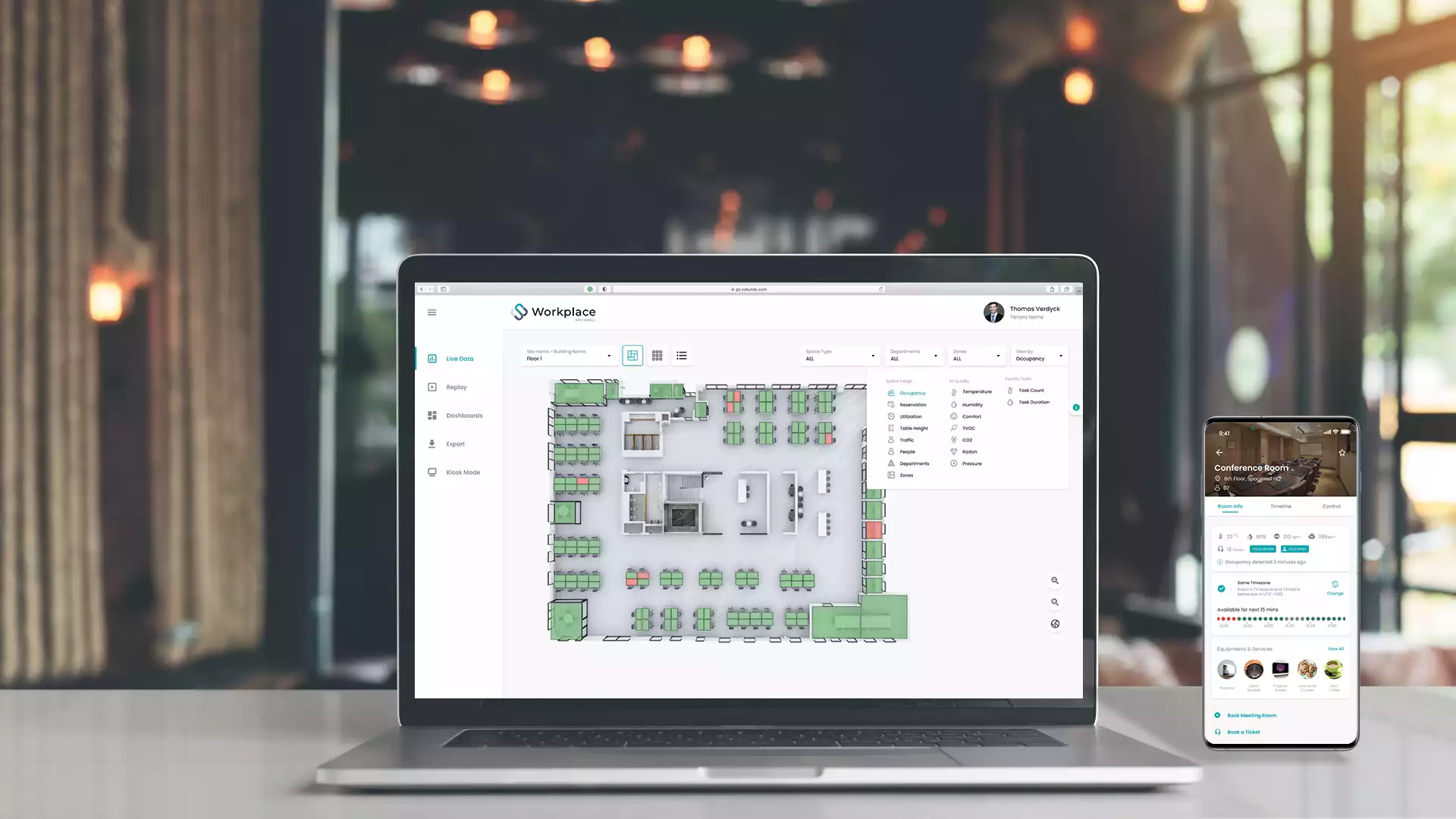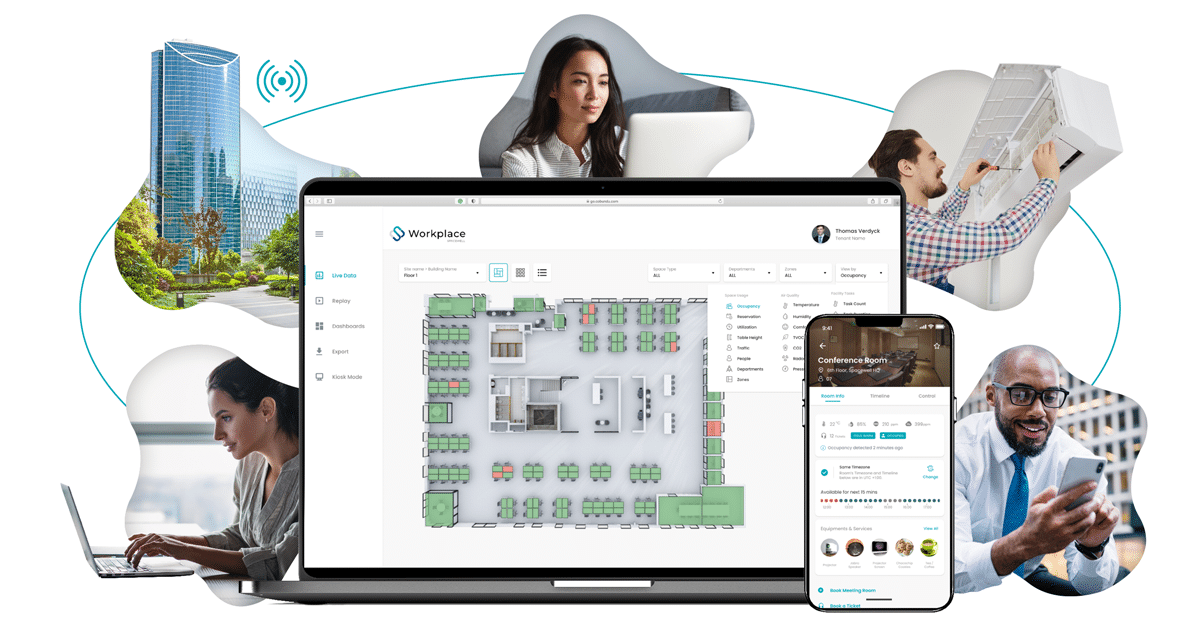Because smart building solutions address today’s critical issues like protecting the environment and the need to improve employee engagement, smart building is a rapidly developing concept.
However, a lot of companies looking to adopt intelligent building principles are struggling to identify the solutions that really meet their needs. That’s why we’d like to show you the benefits your company can reap from deploying the smart building concept and the range of solutions available to you to do just that.
Smart buildings: what they are and how they can benefit you
What’s a smart building?
The term “smart building” refers to solutions based on emerging information and communication technologies that open the way to the automated management of all the equipment in a building and deliver optimal use for the occupants. The goal here is to optimize energy consumption and enhance the comfort and safety of the users of a building while meeting applicable regulations.
The smart building concept is applied in several areas:
- energy management (heating, lighting, etc.),
- managing occupant comfort (air and water quality, light, etc.),
- managing security and access to the building,
- interaction between users and the building environment through sensors, connected objects, and mobile apps.
Suggested reading: What is a smart building?
The benefits of smart building solutions
Energy performance and smart green buildings
Intelligent green buildings are one of the main applications of the smart building concept. This concept delivers substantial energy savings and helps to preserve the environment.
By building these principles right into the very structure, or by fitting out an existing building with the right technologies, you can monitor energy and fluid consumption in real time, predict your operating and energy costs and manage installations and equipment as accurately as possible so that you can control your expenses and limit energy consumption without affecting the comfort of the occupants.
Smart buildings are user-centric
Smart building principles are valuable tools for user comfort. Because the user-centric approach is increasingly valued in all fields of business, the deployment of smart building principles is an asset for attracting and retaining employees and for boosting their productivity.
This enables you to identify needs, improve everyday practices and provide appropriate responses while optimizing the way you manage your assets.
Adapting to new ways of working in companies
Last but not least, smart buildings allow you to adapt efficiently to new ways of working. These have changed considerably in recent years with the significant development of teleworking and roaming, offices are now used primarily for collaborative tasks rather than individual activities.
Using smart building principles and by analyzing your employees’ needs and practices, you can create the ideal environment for each of them.
Suggested reading: Analyzing Hybrid Office Dynamism – Identifying New Office Patterns
Assessing potential ROI to make sure you choose the right smart building solutions
To evaluate the best smart building solutions for your business, it’s important to understand the potential return on investment that sensor-based technologies can bring in terms of space and user experience optimization. Different approaches to calculating ROI are available to give potential investors all the tools they need to estimate the potential gains for their workspace.
Suggested reading: The ROI of Smart Workplace Investments

Space optimization
Space optimization is probably the biggest and most visible potential source of ROI. In fact, if a company can give up a floor or even an entire building by identifying unnecessary space, the gains (in rent, utilities, and services) are both significant and easily quantifiable. Scaling down also avoids unnecessary property investments.
There are three different approaches to space optimization:
- floor space optimization means comparing the total area of a location with the actual requirements based on occupancy and usage data, and involves the use of sensors to provide reporting for data-driven decision making (See also: Optimizing Office Footprint – Accommodating New Ways of Working) ;
- Densification aims to reduce average space per person by accommodating more users in the same space; when done properly, densification does not affect the employee experience at all and also involves the use of sensors;
- Space mix optimization involves reconfiguring work spaces like collaborative conference rooms to align the size of the space with actual usage patterns, so it boils down to aligning demand and supply in such a way that space is primarily used at or near capacity. See also: Optimizing Office Space Configuration – Aligning Supply and Demand)
See also: Occupancy Monitoring & Data-Driven Workplace Optimization
Optimizing energy management
A lot of commercial buildings use their heating and lighting systems indiscriminately, without factoring in the actual occupancy of the building. To curb GHG emissions and reduce energy bills, a smart building can deliver true ROI by intelligently controlling energy use to allocate it only where it’s needed.
Moreover, while energy savings in service companies currently rely mainly on their individual voluntary attitudes, it’s likely that in the future European governments will take coercive measures aimed at sanctioning bad performers through a fine or a tax. This would increase a smart building’s ROI tenfold!
See also: Energy Intelligence. How to Implement an Energy-Intelligent Strategy with IoT
Optimizing the user experience
Optimizing the experience of workspace occupants improves their engagement, thereby leading to gains in productivity and employee retention. This optimization can be divided into 4 aspects:
- the overall objective, which refers to the technologies that can help employees find and access the spaces and tools they need to perform their tasks;
- autonomy enhancement, i.e. the employees’ belief in their effectiveness, which stems from their ability to choose their workspace. A positive feeling of empowerment and satisfaction leads to productivity gains;
- communication, which refers to both creativity-enhancing encounters and teamwork, can be improved by increasing spatial density and making it easier to find colleagues;
- reputation, which is the ability of a company’s image to provide benefits in terms of attracting and retaining talent. This is supported by the degree to which employees feel that they have a high-quality and enjoyable workplace.
See also: How IoT sensor data can improve the workplace experience
Spacewell smart building solutions
Spacewell provides a range of solutions to help you make your buildings smart.
Monitor building use and ambient conditions
With Spacewell solutions, you can monitor the use of any type of space, from meeting rooms and parking spaces to corridors and washrooms. You can access data in real time and analyze it in depth using clickable dashboards.
Using our opportunity simulation tools, you can run space-saving simulations to get a clear snapshot of the financial savings you could be making by combining your occupancy data with the best comparative analysis data.
You can also measure and analyze thermal comfort to improve your users’ well-being.
Lastly, by measuring and analyzing indoor air quality, you can improve energy efficiency, space use, and the quality of the working environment.
See also: How to Improve Indoor Air Quality Using Sensor Data
Help your employees
Spacewell provides a range of tools that make life easier for your employees. For instance, with the Workplace mobile app, they can control everything from their smartphones, including floor plans, locating colleagues, ordering equipment or catering services, and accessing real-time occupancy data.
We also provide an interactive large-screen terminal, which recommends suitable spaces based on the number of visitors and makes it easy to book workstations, meeting rooms, or services.
Our wall-mounted, touch-sensitive meeting room display eliminates ghost meetings and curbs wasted resources.
Finally, the Outlook add-on delivers all the features provided by Spacewell (live floor plans, workspace searches, etc.) while remaining in the standard Outlook environment.
See also: The Workplace platform: All-in-One Global Workplace Solution

Transform your working environment with Spacewell solutions
With Spacewell smart building solutions, you can go even further and transform your working environment so that it seamlessly matches your organization’s core business, improving the quality and responsiveness of maintenance, facility management, and hospitality services.
See also: AXA Belgium – a smart building for a new work culture
Far from being an abstract and obscure concept, the smart building concept delivers a set of high-tech solutions which companies can draw on to create the environment that suits them best. Using these tools, businesses are empowered to meet the considerable challenges they face in terms of human resources, profitability, and energy consumption.







